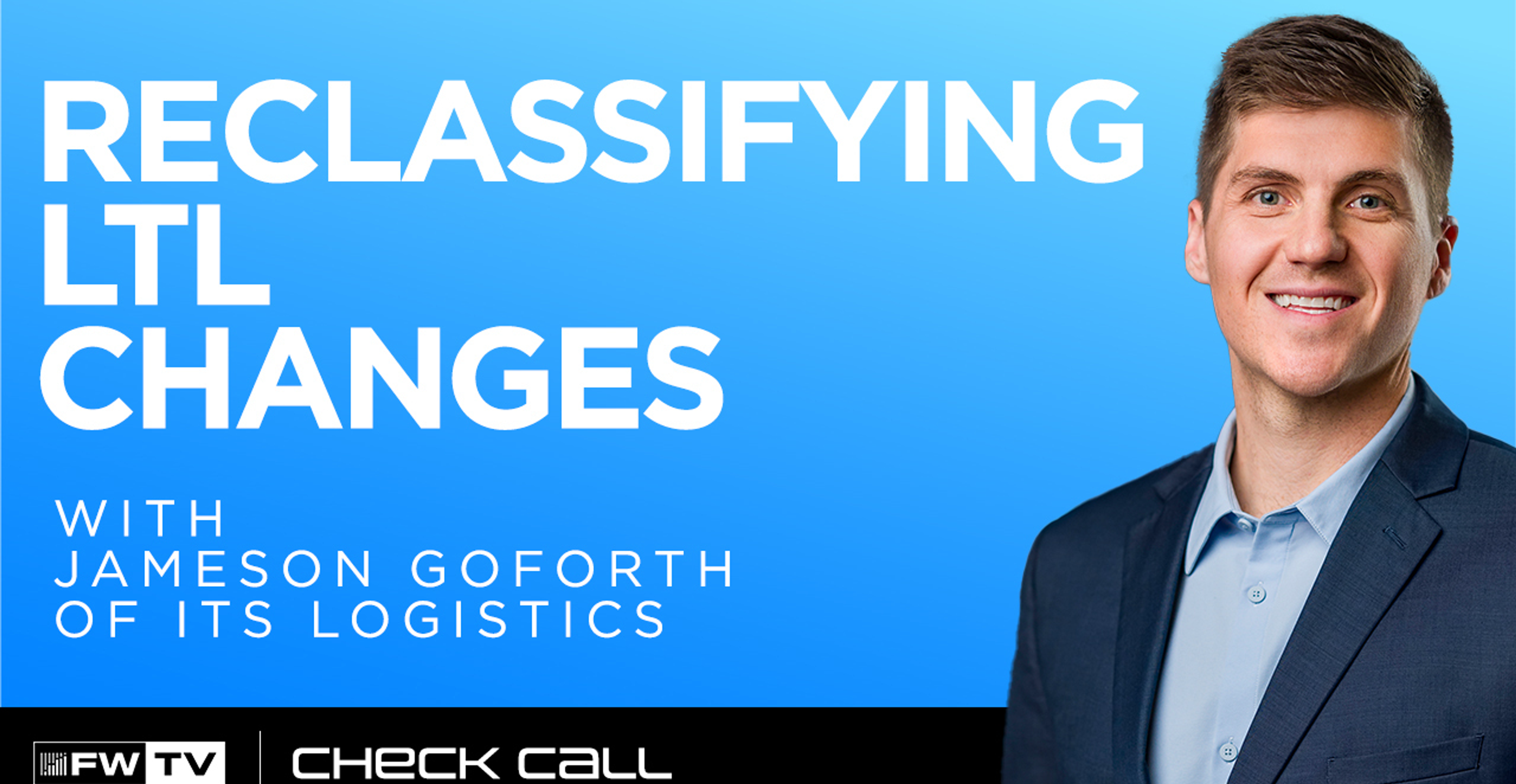Ask the Expert: Declassifying Upcoming NMFC Changes with Jameson Goforth

The NMFTA is planning major changes to how LTL freight is classified, threatening potential disruption for carriers and shippers alike. To better understand how the changes will impact the freight market and build strategies for a smoother transition, we spoke to Jameson Goforth, VP of Final Mile at ITS.
The National Motor Freight Traffic Association (NMFTA) has announced upcoming changes to their classification system and technology, set to go into effect on July 19th of this year.
The NMFTA’s National Motor Freight Classification (NMFC) is a standardized system used to classify freight for less-than-truckload (LTL) shipping purposes throughout North America. Since 1956, carriers and shippers have relied on the freight classification system to ship LTL freight. Under the NMFC, loads are evaluated by density, handling needs, stowability, and liability to receive a classification number ranging from 50 to 500, with more favorable freight on the lower end of the range. These classifications provide a standardized way for shippers and carriers to communicate what is being moved, and how much it will cost to move it.
But as goods have become more diversified, supply chains more strained, and technology more advanced, the classification system has come under scrutiny for being outdated and overly complex. In response, the NMFTA has chosen to enact a major overhaul, reclassifying thousands of items, condensing categories, and aligning classifications with actual shipping needs.
While the updates will ultimately result in a more common-sense system, the transition poses challenges. To help shippers, carriers, and 3PLs better understand the changes and how to avoid disruptions, we tapped ITS Logistics’ VP of Final Mile, Jameson Goforth:
What do you anticipate being the biggest challenge of this change?
The biggest challenge of this change is absolutely going to be navigating pricing changes. Today, for example, shippers are moving freight that’s classified as class 300. After the change, that same freight is class 125. Nothing has fundamentally changed about the shipment, but suddenly, the carrier is seeing meaningfully less revenue—and their costs haven’t changed at all. Conversely, maybe a shipper has been paying $125 for a shipment. That shipment is reclassified, and now it costs $250—even though it’s the same items, same lane, same carrier it's always been. That’s a price increase shippers must factor into their costs and bottom line. You can see how these NMFC code changes may cause some uncomfortable conversations. And I think open communication and handling them proactively and strategically will be the biggest challenge—especially for carriers.
Why do you think this will be a bigger challenge for carriers than shippers?
First and foremost, a lot of LTL carriers don’t have systems in place to easily identify their shippers by NMFC code. That means they’ll have to go through their accounts manually to determine which of their customers are being impacted by the changes—whether that's boots on the ground or using their sales data to identify which customers have been affected.
Then, they have to re-underwrite all of their pricing, deciding whether they’re going to give customers discounts on certain goods, or increase prices, or no longer move certain goods because it’s not profitable.
After making those decisions, they’ll need to go to their customers and have those conversations about price changes. These are delicate conversations, because if I, as a carrier, am going to get less revenue for the same cost, that’s a problem. But it’s also a problem if I’m going to be charging more for the same cost, right? There will probably be carriers that don’t even touch price increases and take a “wait and see” approach on the goods that have price increases. I don’t think that’s a good long-term strategy. Rather, I think the best carriers are going to address both price increases and decreases and do what’s right by their shippers by being transparent and fair.
What proactive steps should shippers be taking to prepare for these changes?
First and foremost, find out if you’re impacted. There are some ten thousand item codes included in this change. The NMFTA is making all this information readily accessible on their website. If you are affected, right now is the time to start a conversation with your carrier partners. Ask them what their plans are. Are they planning to adjust pricing to get to cost neutral? Are they going to leave their pricing as is? If that’s the case, are there potentially other carriers who now offer better rates for a similar service product? The major step right now is to find out if you’re impacted. Your capacity partner should be reaching out to you now, but if they aren’t, you need to be reaching out to them.
How long do you think we’ll see disruptions based on these changes?
I think this is going to be a relatively smooth transition for those who are prepared. The NMFTA has provided plenty of lead time for everyone to identify whether their freight is affected, reevaluate their strategies, and plan for price changes.
Not everyone will have taken advantage of the lead time they have, though. So, when these changes go into effect, we’re going to see a lot of reclassifications on the carrier side that will result in freight bill adjustments after the fact. Shippers are going to start getting invoices that don’t match their quotes, and they’re going to ask their carriers, “What’s going on? Why has this changed?” I would anticipate several months of choppy water while those who did not manage the change effectively scramble to renegotiate their pricing and look for new capacity partners.
How is ITS preparing for this change?
We keep our customer base segmented by NMFC freight classification. We’ve already checked our existing customer base against the in-scope changes and started those conversations with our carriers. We’re going to them and saying, “Hey, we know this freight is going to be affected, what are your plans?” Initially, we received a lot of blank stares. But because we approached this early, a lot of our carriers are getting us updated pricing way ahead of the deadline. Now, we can loop in our shippers to update them on the changes and ensure they’re getting fair market rates on their LTL shipments.
This is where the real value of a 3PL partner or brokerage comes in. You’re paying someone to manage the change. Someone who spends every day on the market, has strong partnerships with good carriers, and wants to be proactive and ensure everyone is on the same page.
Are you excited about this change?
I am. The new classifications eliminate a lot of the frustrations we deal with shipping LTL every day. Take T-shirts, for example—there’s subcategories for t-shirts, uniforms, disposable shirts—they all ship the same. Let’s just capture it all in one place and make it easier for everyone.
The new tool is also supposed to have API capabilities, so if you’re in a TMS, you can pull and look up codes in your own system. You don’t have to leave and go into the NMFC program and look stuff up. And there should be much better search functionalities. It’s going to make life a hell of a lot easier for everyone.
What final advice do you have for shippers ahead of July?
Take this time to reevaluate whether you’re currently market competitive. Are you underpaying? Are you overpaying? Do you even know? This change is a great litmus test to see if you have a truly strategic capacity partner who is willing and able to work through major changes with you.
The freight classification changes are set to take effect July 19th, 2025. The NMFCA is providing several listening sessions and webinars over the next several months designed to help LTL carriers and shippers understand the NMFC changes and experience the new freight classification tool, ClassIt+. Visit the NMFCA’s site here to access resources, guides, and FAQs.
Navigate Change Seamlessly with the Right Partner
Less than a month in, 2025 is proving to be a dynamic year for the freight market. ITS Logistics leverages decades of expertise to guide shippers through unexpected shifts and ensure seamless experiences for themselves and their customers.
Our approach to LTL helps you meet your cost and service goals by matching shipping volume, destination zones, and budget with the optimal combination of national, regional, and niche carriers in our network. Our team manages every aspect of the process, so you don’t have to—providing you with a single, reliable touchpoint for your LTL shipments.
Reach out to learn more about ITS Logistics and find a creative logistics solution to save on your LTL shipments.
Meet Jameson Goforth, Vice President of Final Mile
With over 17 years of LTL experience, Jameson specializes in helping companies of every size maximize efficiency and value in their supply chain. Start a conversation and learn more about how our team can help improve your LTL by messaging him at jgoforth@itslogistics.com.



